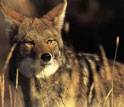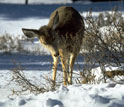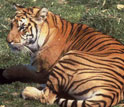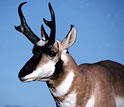News Release 12-072
Scientists Trace Evolutionary History of What Mammals Eat
Feeding habits haven't always been what they are today

Black bears are fond of berries, and will go far out of their way to find them.
April 16, 2012
This material is available primarily for archival purposes. Telephone numbers or other contact information may be out of date; please see current contact information at media contacts.
The feeding habits of mammals haven't always been what they are today, particularly for omnivores.
Some groups of mammals almost exclusively eat meat--take lions and tigers and other big cats as examples.
Other mammals such as deer, cows and antelope are predominantly plant-eaters, living on a diet of leaves, shoots, fruits and bark.
But particularly for omnivores that live on plant foods in addition to meat, the situation wasn't always that way, finds a new study by researchers working at the National Evolutionary Synthesis Center in Durham, North Carolina.
The results appear today in the online edition of the journal Proceedings of the National Academy of Sciences.
"The research links dietary strategy, a basic aspect of animal ecology, with macroevolutionary diversification of mammals," said George Gilchrist, program director in the National Science Foundation's (NSF) Division of Environmental Biology, which funded the research.
"It's impressive that ecology has such a strong and clear influence on lineages stretching back millions of years. Darwin would be delighted with this paper."
Past research shows that animals with similar diets tend to share certain characteristics.
But this study is the first of its kind to look across all mammal groups, including omnivores, to reconstruct how evolutionary time changed mammal diets.
To do that, the researchers compiled previously published diet data for more than 1,500 species representing more than one third of mammals alive today, including primates, ungulates, bats, rabbits and rodents.
By mapping that data onto the mammal family tree, the researchers were able to trace backward in time and infer what the ancestors of each species most likely ate.
They found that while some groups of mammals maintained steady diets, others changed their feeding strategies over time.
Today's omnivores in particular--a group that includes primates, bears, dogs and foxes--came from ancestors that primarily ate plants, or animals, but not both, said paper co-author Samantha Price of the University of California Davis.
While omnivorous mammals weren't always that way, plant-eaters and meat-eaters have diversified within a more well-worn path.
Radical shifts were unlikely for these animals. Mammals that eat meat for a living, for example, didn't give up their taste for flesh without transitioning through an omnivorous stage first.
"Direct transitions from carnivory to herbivory were essentially nonexistent," said co-author Louise Roth of Duke University.
"It's an intuitive result because it takes very different kinds of equipment to have those kinds of diets."
"Plant- and animal-based foods require different digestive chemistries and different processing mechanisms in the mouth and stomach," said co-author Samantha Hopkins of the University of Oregon.
The kinds of teeth adapted for tearing and slicing meat are different than the large, flat-topped molars adapted for grinding nuts and roots.
"It makes sense that you couldn't easily transition from one to the other in one step," Price said.
The researchers also found that diet is linked to how fast mammals spawn new species.
As new species arise and others go extinct, the plant-eaters proliferate faster than their meat-eating counterparts, with omnivores lagging behind both groups.
"If there was an evolutionary race to evolve 100 species, it would take three times longer for omnivores compared to herbivores, and carnivores would be in the middle," Price said.
-NSF-
-
The adaptable coyote, usually considered a carnivore, will also eat berries.
Credit and Larger Version -
Deer browse on plants, often defoliating shrubs and trees in suburban yards.
Credit and Larger Version -
Tigers are carnivores with a shrinking range in Asia and the Russian Far East.
Credit and Larger Version -
Pronghorn antelope graze their way across fields in the U.S. mountain west.
Credit and Larger Version
Media Contacts
Cheryl Dybas, NSF, (703) 292-7734, email: cdybas@nsf.gov
Robin Ann Smith, NESCent, (919) 668-4544, email: rsmith@nescent.org
The U.S. National Science Foundation propels the nation forward by advancing fundamental research in all fields of science and engineering. NSF supports research and people by providing facilities, instruments and funding to support their ingenuity and sustain the U.S. as a global leader in research and innovation. With a fiscal year 2023 budget of $9.5 billion, NSF funds reach all 50 states through grants to nearly 2,000 colleges, universities and institutions. Each year, NSF receives more than 40,000 competitive proposals and makes about 11,000 new awards. Those awards include support for cooperative research with industry, Arctic and Antarctic research and operations, and U.S. participation in international scientific efforts.
Connect with us online
NSF website: nsf.gov
NSF News: nsf.gov/news
For News Media: nsf.gov/news/newsroom
Statistics: nsf.gov/statistics/
Awards database: nsf.gov/awardsearch/
Follow us on social
Twitter: twitter.com/NSF
Facebook: facebook.com/US.NSF
Instagram: instagram.com/nsfgov




